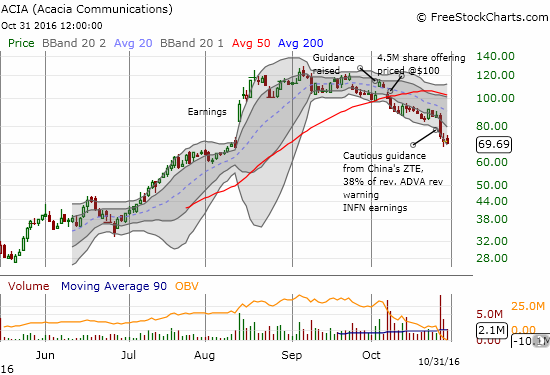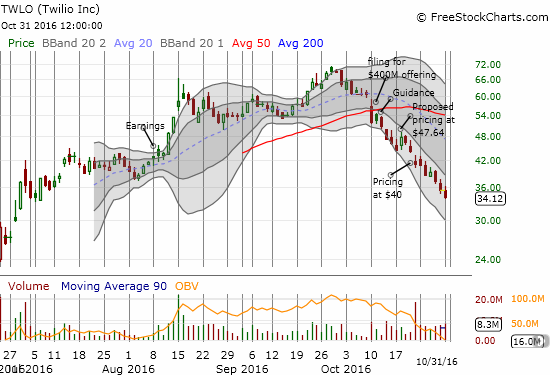I raise yellow flags when companies implement a secondary stock offering soon after going IPO, especially after the stock has experienced a massive run-up. I get even more worried when the majority of the shares are being sold by shareholders rather than the majority of proceeds going into corporate investments. Two recent IPOs have popped onto my radar after large post-offering losses under these kids of circumstances: Acacia Communications, Inc. (ACIA) and Twilio, Inc. (TWLO).
On October 4, 2016, Acacia Communications, Inc. (ACIA) announced an increase in guidance in an SEC filing for the previous quarter:
“Based on preliminary unaudited information and management estimates for the three months ended September 30, 2016, and subject to the completion of its financial closing procedures, the Company now expects revenue of $130 million to $133 million, GAAP net income of $28 million to $31 million, non-GAAP net income of $34 million to $37 million, GAAP diluted earnings per share of $0.68 to $0.75 and non-GAAP diluted earnings per share of $0.83 to $0.90 for the three months ended September 30, 2016.”
ACIA reported the following guidance in its last earnings report: revenue $120.0M to $128.0M, non-GAAP net income $26.0M to $31.0M, non-GAAP diluted earnings per share $0.64 to $0.76.
In parallel, ACIA announced in a press release its intent to offer more shares to the market:
“Acacia is proposing to sell 1,210,302 shares of Acacia common stock, and certain selling stockholders are proposing to sell 3,289,698 shares of Acacia common stock. In addition, the underwriters have been granted a 30-day option to purchase up to an additional 675,000 shares of Acacia common stock from certain of the selling stockholders.
Acacia intends to use proceeds from the offering for working capital and general corporate purposes. Acacia will not receive any of the proceeds from any sale of shares by the selling stockholders.”
The stock market initially responded very well to the news as the stock gapped up and closed with an impressive 11.3% gain. The enthusiasm waned from there and turned into a rout after ACIA announced a $100 price for the stock offering. Given the stock closed over $113 on October 4th, this markdown implied softening demand for the shares. The very next day, ACIA dropped down to $92.50 and confirmed the weak demand. Last week ACIA received another wallop from revenue warnings from China’s ZTE and Germany’s ADVA Optical Networking which together constitute a large portion of ACIA’s revenues – ZTE is reportedly a lion-sized 40% of ACIA’s revenues. ACIA has a very concentrated customer base with 82% of revenues coming from five customers. Note that even with recent losses, ACIA is still up 125% from its close on its first day of trading. ACIA priced its IPO at $23/share.

ACIA next delivers earnings news on November 10th. This event will be a chance for the company to reignite excitement about the stock and revitalize confidence. Investors and analysts will surely seek clarification on ACIA’s increased guidance just three weeks before major customers warned on their respective businesses. The audience will likely look to see whether ACIA beats as hasty retreat on further guidance. At face value, the timing of the increased guidance combined with the offering suggests at best that ACIA has poor visibility on its business. I will be watching the post-earnings reaction very closely.
Twilio (TWLO) has had a very rough month of October. TWLO was up 124% from its close on the first day of trading to the end of September and proceeded to lose 47.0% over October. During that slide, on October 7th, TWLO registered for a proposed follow-on offering:
“A majority of the shares in the proposed offering are expected to be sold by existing stockholders. Twilio will not receive any proceeds from the sale of the shares by the selling stockholders. The number of shares of Class A common stock to be sold and the allocation of the shares between Twilio and existing stockholders has not yet been determined.”
The accompanying SEC filing set the maximum value of the offering at a whopping $400M. The next trading day (October 10th), TWLO gapped down, broke down below 50DMA support, and closed with a 11.1% loss. The next day, TWLO released preliminary results for the quarter ending September 30th in an SEC filing. The stock market responded with a lukewarm reception that ended with a fade into a flat close. On October 18th, TWLO filed more details on its offering and priced shares at $47.64. With the stock closing at $44.45 the previous day, it seemed that demand was strong. The market promptly rallied TWLO to a $47.77 close. Yet, TWLO resumed the sell-off from there and has managed just one up day since. On October 20, TWLO conceded to market pressure and set the official price of its offering at $40/share. This concession confirmed the weak demand for shares…
“…the pricing of its public offering of 7,000,000 shares of Class A common stock at a price of $40.00 per share. 641,222 of the shares are being offered by Twilio and 6,358,778 of the shares are being offered by certain selling stockholders. Twilio will not receive any proceeds from the sale of the shares by the selling stockholders. In addition, Twilio has granted the underwriters a 30-day option to purchase up to 1,050,000 additional shares of Class A common stock from Twilio at the public offering price.”
The next day, TWLO fell to $41.06 from the previous day’s close at $44.14. At $34.12, TWLO is still trading up 18.5% from its close on the first day of trading. TWLO priced its IPO at $15.

Source for charts: FreeStockCharts.com
The warning signs were not quite as timely for TWLO as they were for ACIA. Yet, the technicals were just as bad if not worse. TWLO is now in danger of reversing all its gains since the stock first opened for public trading. The company next reports earnings this week on November 3rd. This event will be a major test of the company’s ability to tell a good story and maintain interest in these shares.
Jim Cramer from TheStreet.com and CNBC’s Mad Money is a devoted fan. As late as October 21, Cramer described TWLO as his favorite IPO of the year.
After TWLO’s first earnings report as a public company, Cramer applauded TWLO’s results:
“‘It was one of the great conference calls. It was a beautiful conference call…Beautiful story. They talk about the era of investing, super network. Twenty-two data centers, seven regions…'”
TWLO desparately needs an encore this week!
Be careful out there!
Full disclosure: no positions
